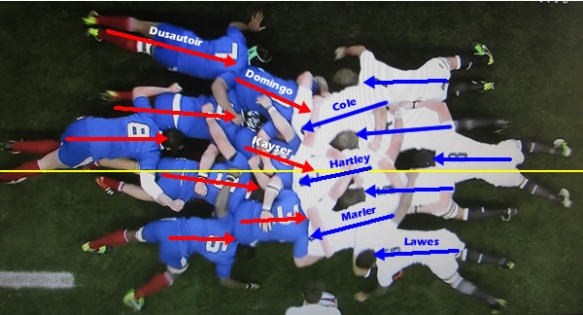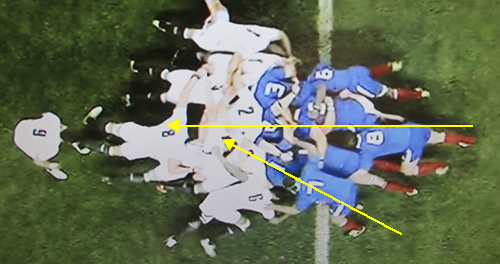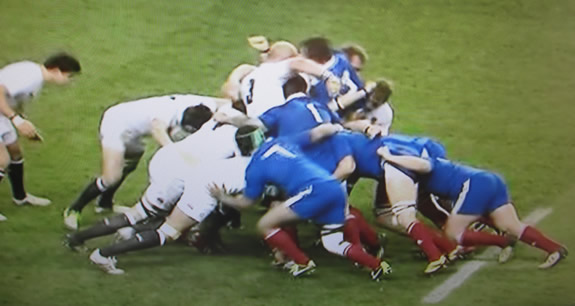The common story after England’s 23-13 win over France was that England had overcome a few set-piece issues and used their bench wisely to find some final-quarter dominance and ‘grind out’ their third Six Nations victory of the 2013 season. “With Thomas Domingo giving Dan Cole all manner of scrum problems, the lineout wobbling and tackles being missed far too often, Lancaster’s side had no foundations to build on,” was one of the lines that caught tGL’s attention; not because of the lineout wobbling (which it did) or the tackles being missed (which they were), but the part about Domingo giving Cole ‘all manner’ of scrum problems. Domingo certainly gave someone a lot of scrum problems at Twickenham, but it wasn’t Cole, it was referee Craig Joubert.
Credit must go here to England’s former second-row forward Ben Kay (@BenKay5) who offered a dissenting voice to the general narrative of England’s ‘scrum problems’ in his Daily Mail column. Kay highlighted Domingo’s key tactic, but didn’t go as far as to condemn it, which he really should have done. He noted that Joubert looked like he didn’t want to referee the scrum, then made reference to the considerable difference between the players’ respective heights, Domingo 173cm and Cole 189cm, before saying: “Domingo caused Cole problems by packing down at an angle rather than straight, as the law says props should. He was thus able to slide his body across Cole and push him up. That’s why he was having so much success because he was not bringing his shoulder square and was popping under Cole and lifting him.”
It was clear that when the shove started Domingo certainly wasn’t pushing anywhere close to straight. As a shorter man, Domingo has a naturally lower starting pivot point than Cole which allowed him to manoeuvre his head under and into Cole’s shoulder area instead of staying ‘ear-to-ear’ at the set. He then adjusted his pushing angle and directed as much pressure as possible, levered by flanker Thierry Dusautoir behind him, at Cole’s chest. This is commonly known as ‘boring in’ and will, unsurprisingly when a combination of twice your own weight is forcing you in a certain direction, cause the target of the pressure to ‘pop up’ out of a scrum. It’s essential to note that this is punishable with a penalty, but against the offending loosehead, not the suffering tighthead, as happened at Twickenham.
The picture below shows the match’s second scrum, in the ninth minute, about two metres outside France’s 22. It resulted in a reset after the scrum wheeled through 90 degrees clockwise, and clearly shows Domingo’s strategy.
The yellow line is parallel to the sideline and, in theory, indicates the direction the players should push. As you can see, the body angles of Dusautoir and Domingo at the top of the picture are not close to being parallel to the yellow line and are already forcing England’s front row (as a unit) to the left because of the pressure applied to Cole’s right side. Compare Dusautoir’s angle to that of Courtney Lawes at the bottom of the picture in support of his loosehead Joe Marler.
Here’s what the rules say on the subject. Law 20.8 (i) covering front-row players: ‘A front row player must not lift an opponent in the air, or force an opponent upwards out of the scrum, either when the ball is being thrown in or afterwards. This is dangerous play. Sanction: penalty kick.’
Worse still is that not only was this very clear to identify to anyone who can read the signs, but most of the time it was happening on the side of the scrum where Joubert was standing, indicating he had little idea what he was looking for. Not only did Joubert fail to control this ‘popping’ tactic, but he allowed Domingo to profit from it, hence the idea that Cole had a bad day at the office.
There were nine scrums in the first half and Domingo’s angled attack was present in all but the first when England were penalised for an early engage. In the ninth minute (scrum shown in picture above) the tactic wheeled an England scrum into the ground that had to be reset and then led to a France free-kick. France opted for another scrum, Joubert lectured England’s front three before formation and then penalised Cole seconds later for standing. France kicked the ball from their own 22 five metres into England’s half. Domingo continued the tactic for the rest of the half and destroyed another three scrums without sanction from Joubert, who simply opted to play through the mangled scrums as long as the ball was close to being available, despite Law 20.3 (h) covering binding in the scrum saying: ‘If a scrum collapses, the referee must blow the whistle immediately so that players stop pushing.’
After earning his team a free-kick and penalty territory, as well as causing general mayhem and injury risk in the first half, Domingo’s illegal tactic earned yet another scrum penalty for his team in the opening minute of the second half, despite Joubert standing on his side of the scrum and with a perfect view of events just a couple of metres away. In the picture below, you can clearly see Domingo’s pushing angle in relation to that of his hooker Kayser; a perfect 30-degree variation designed to force Cole upwards out of the scrum. It’s also worth noting that with the adjusted pushing angle it was impossible for Kayser to maintain the same full bind on Domingo as he had on his tighthead prop Nicolas Mas, which was a constant throughout the match.
The picture below is just a split-second later as the players are standing up and Joubert (who has the same view) is just about to award France their penalty, but pay attention to the position of Domingo’s head coming out from under Cole’s arm as if he’s just released him from a headlock. If he was pushing Cole anything close to squarely he would have been the other side of Cole’s arm.
The penalty could have been pretty significant. It was 10 metres in England’s half and very kickable with the score already in France’s favour at 10-9, but Morgan Parra didn’t find the posts. It was the match’s turning point as Owen Farrell kicked a penalty to put England ahead a few minutes later and then, just after that, another scrum deep in England’s half allowed Cole to get some revenge by taking the law into his own hands.
Maintaining his bind on Tom Youngs to his left, Cole redistributed the majority of his weight on to his outside (right) shoulder so that on the set of the scrum Domingo couldn’t get under him enough to get any traction and his head and shoulders automatically rolled down towards the ground as a result of his own momentum. Cole lost his bind as Domingo’s position changed and the scrum collapsed; Joubert ordered a reset. Cole did the same thing on the reset this time turning his outside shoulder in to send Domingo to ground first. Joubert awarded a free-kick to England and an Andy Goode up and under and some midfield ping-pong later, Manu Tuilagi grabbed the ball and stretched England’s lead to 17-10.
Coincidence or pre-planned, moments later Domingo and hooker Kayser were replaced by Vincent Debaty and Dimitri Szarzewski, respectively. In the match’s two remaining scrums, Debaty never got a decent bind on Cole; England pushed through France’s front row and earned a penalty from the first and France just managed to get the ball away before the formation disintegrated during the second.
It reminded tGL of the Lions’ 26-21 first-Test defeat against South Africa in 2009. That match was – arguably – won in the first half by a succession of penalties given against the Lions as Springbok loosehead Tendai ‘Beast’ Mtawarira propped low and at a very similar angle to Domingo to ‘terrorise’ tighthead Phil Vickery. On that occasion the referee Bryce Lawrence failed to recognise what was happening and it ultimately cost the Lions the Test. France didn’t profit in the same way as Mtawarira and South Africa in 2009, but Domingo’s performance at Twickenham shows that not only refereeing the scrum, but understanding it, is a key issue, and that Dan Cole’s scrummaging reputation is still very much in tact.




In this case, should a tighthead use his bind to manipulate his opposite and further exaggerate the bore? At least this way, a struggling referee has a better chance of noticing the loosehead’s arse pointing at the sideline. The risk there could be that he is helping the loosehead around to either a) get beat worse b) win a penalty and stop the bore for good.
Interesting idea, but it’s a risky policy. In this case the infringement against Cole was pretty obvious and still wasn’t acknowledged – who’s to say an even more obvious infringement wouldn’t receive the same treatment? Changing the other prop’s boring angle by getting as low as possible and forcing his shoulders below his hips is the way to do it, it’s just tough against a guy like Domingo who is so close to the ground to start with…
This is all part of propping, I knew because I propped for 15 years.
My conclusion is the refreees haven’t got a clue but in my eyes Cole and especially Vickery took a big hammering.
This is part and parcel of game, Cole is still an excellent tight head and Vickery is a legend.
Very fair point Will, what would have been your solution against a player of Domingo’s size?
A good short stocky loosehead was always your most feared opponent as a tighthead.
The best solution would be to face a similar opponent more often which is probably not possible in this age of giant props.
If Cole played Domingo every week he would work out his own answers.
I think Cole made a lot of progress in respect of his own answers during the match, favouring his right shoulder on the set to change Domingo’s angle for example, but I also can’t help think that having Tom Youngs inside him instead of Hartley helped a bit.
@Will (or anyone else) I’ve often heard stockier loose heads called “old school.” Is this sort of what people are referring too? Now a days props are much taller, and I assumed that taller loose heads had the potential to use much longer levers on a much larger proportion of their opposites body and therefore could affect the other teams’ scrums. This is an area that I (and surely many coaches) could stand to be better versed in.